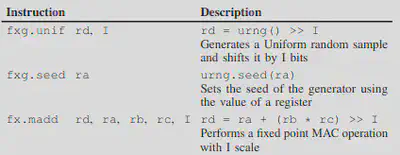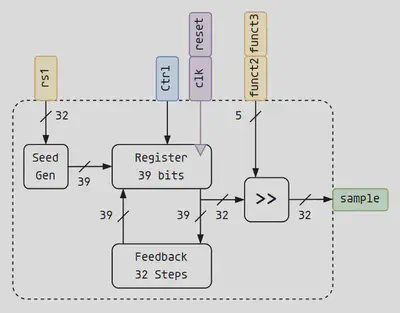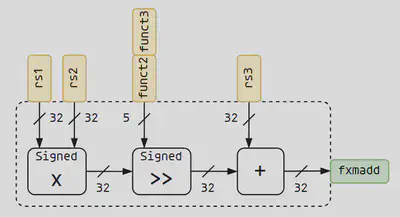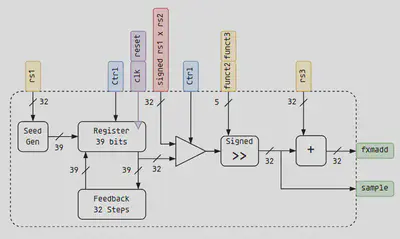ISA extension for RISC-V architecture for probabilistic functions
Bayesian neural networks (BNNs) allow us to obtain uncertainty metrics related to the data processed, and the uncertainty generated by the model selected. We have identified how these metrics can be used for several practical applications such as identifying predictions that do not reach the required level of accuracy, or identifying when the predictions are affected by the increase of the level of noise in the input data. However, it is important to consider the increased computational cost associated with BNNs, as their probabilistic nature requires more complex inference methods. These ISA extensions can reduce the need for costly softwarebased approximations and enable more efficient utilization of hardware resources, making Bayesian deep learning more practical for realtime and edge computing applications
BnnRV Toolchain
BnnRV is a toolchain designed to generate
optimized C source code for the inference of BNN
models trained using BayesianTorch. By
translating trained models into C, BnnRV enables
the deployment of uncertaintyaware NNs on
resourceconstrained devices.
A forward pass of a BNN requires sampling the
weight distributions learned during training. These
distributions are Gaussian and need to be generated
using a Gaussian RNG algorithm.
Gaussian sampling remains computationally
expensive, even when using a simple algorithm. To
address this issue, we have proposed an
optimization that replaces Gaussian distributions
with Uniform distributions for inference,
significantly reducing the computational
complexity of weight sampling.
This optimization leverages the Central Limit
Theorem (CLT), assuming that the outputs of BNN
neurons follow a Gaussian distribution, even if the
weight distributions themselves are not Gaussian.
BNN neurons, like those of traditional NNs,
perform MAC operations. These accumulation
operations are the basis for applying the CLT.
The code for BNN inference, incorporating the
Uniform weight optimization, relies on a Uniform
RNG algorithm and two fixed point MAC
operations: the first for weight generation and the
second for the standard weight accumulation used
in NNs. A fixed point MAC operation involves a
bit shift to adjust the scale after the multiplication,
resulting in a total of three instructions per MAC
operation.
Extending RISC-V
These ISA extensions can reduce the need for costly softwarebased approximations and enable more efficient utilization of hardware resources, making Bayesian deep learning more practical for realtime and edge computing applications.We have enhanced the performance of BNN inference with two new key instructions, a fixed point MAC, and a Uniform RNG. Additionally, a complementary instruction for random seed configuration was included for completeness.

Using this extension, the critical computation of
BNN inference only requires executing three
assembly instructions, which will require only
three cycles in our RISCV core.
To implement the Uniform RNG functional unit, a
lookahead linear feedback shift register (LFSR)
was used. A LFSR consists of a register and a
feedback network that uses XOR gates to
implement a generating polynomial, producing one
random bit per cycle. However, generating multiple
bits with low correlation requires a more complex
method. To generate 32bit samples, this work
utilizes a 39bit LFSR with a 32step lookahead
mechanism and a shifter to set the scale of the
sample.
To generate 32bit samples, this work utilizes a 39
bit LFSR with a 32step lookahead mechanism
and a shifter to set the scale of the sample. The
fixed point arithmetic unit uses a discrete 32bit
multiplication hardware, a 32bit adder, and a
shifter.

The fixed point arithmetic unit uses a discrete 32
bit multiplication hardware, a 32bit adder, and a
shifter. The fixed point scale represents the number
of bits assigned to the fractional part of a number and
can be stored using 5 bits for 32bit precision. The
fx.madd instruction uses the R4 RISCV encoding.
This encoding provides 5 control bits divided in
two fields, funct2 and funct3. The 5bit size allows
encoding the scale value, used to define the number
of bits assigned to the fractional part of a number,
within those fields as an immediate, within the 32
bits of the instruction format.
Using immediate values means that the code needs
to be recompiled every time the fixed point scales
change, which should not often occur after the
BNN model is deployed.

A more optimized implementation combines both functional units and shares the shifter hardware. In addition, instead of using a discrete multiplier, it uses the multiplier hardware already present in the base RISCV core, reducing the area requirements

Experimental results
On average, sampling a Uniform distribution using the software method proposed achieves a speedup of 4.94×, while utilizing the proposed RISCV instructions results in a 8.93× speedup.
The optimized implementation results in an average energy consumption reduction of 87.79%.
